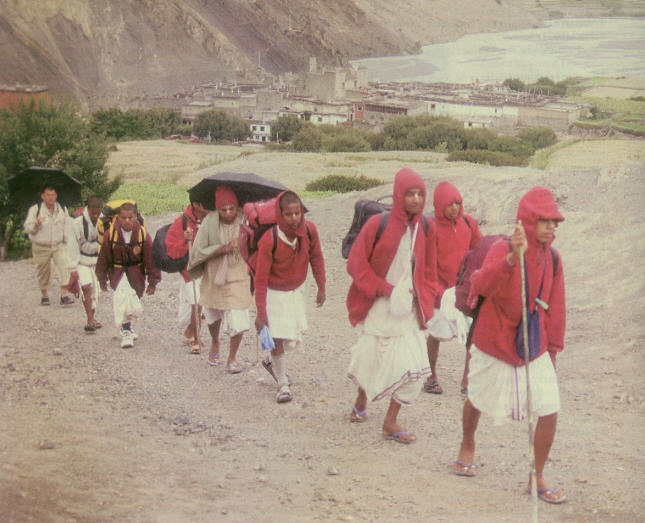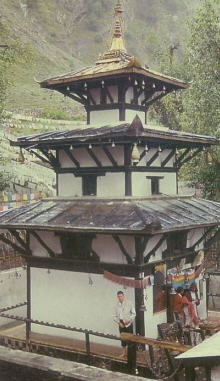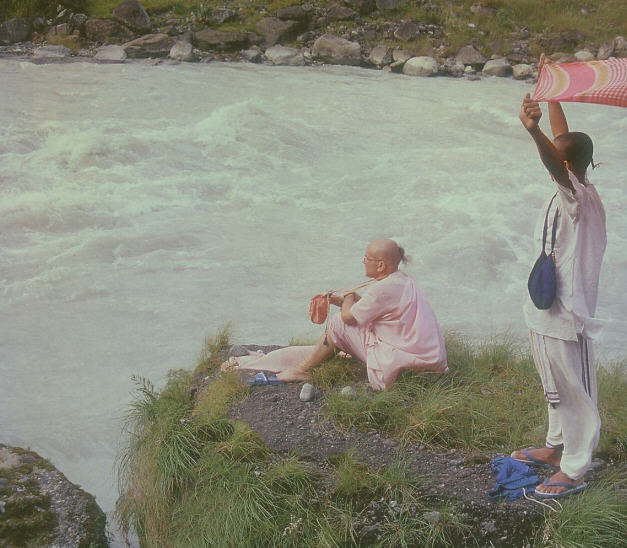Equipped with Krsna's books and His holy name, a group of students
go on pilgrimage from the plains of Bengal to the high Himalayas.
August 3, 2000, Mayapur, West Bengal
EIGHT BOYS, AGES twelve to sixteen, join me on a northbound bus headed for the temple of Muktinath in the Himalayas. They are students at ISKCON's boys school in Mayapur, where I teach. Most of them have never been out of Bengal. They're excited about the trip, of course, but they're also looking forward to another kind of adventure: the chance to introduce people to Krsna consciousness.
August 11, Katmandu, Nepal

So much has happened already. When we crossed into Nepal, we had to wait several hours for our bus connection, so we decided to pass the time at a nearby Hanuman temple. The priest in charge was very friendly and treated us like honored guests.
We decided to try to distribute some of Srila Prabhupada's books. Without even leaving the temple, we unexpectedly sold six Bhagavad-gitas. We couldn't speak Nepali, and most of the boys had never done book distribution before. I felt that Krsna was inspiring people to come and get His words.
I found Nepalis to be religious, devotional people. They were quite interested to speak to a Western devotee of Krsna (I'm from South America). Their pride in their Vedic heritage was particularly apparent at Durbar Square, a striking assembly of ancient temples and palaces where Nepali kings are crowned and their coronations solemnized. The boys and I set about distributing some of Srila Prabhupada's books, which were well received by both local people and tourists.
August 16, Bhaktapura
We went to this town near Katmandu during the festival of Gayatra. Many Nepalis joined our chanting procession as part of similar events surrounding the festival.
August 18, Katmandu
One young lady named Veronica had just arrived from Austria. She said she was fed up with the materialistic "rat-race, exploitive society" and had come to Nepal seeking higher knowledge. She eagerly accepted Prabhupada's books and discussed Krsna consciousness with us at length.
One of my students, sixteen-year-old Hariscandra, had his first taste of book distribution.
"I had no idea what to do," he told me. "But I found that the people were friendly and generous. There were some rough people, but most would listen, and I found myself greatly enjoying book distribution."
A particularly good philosophy student, Hariscandra was honored one morning with an invitation to give the Srimad-Bhagavatam class in the ISKCON Katmandu temple.
August 24 (Srila Prabhupada's Vyasa Puja), Katmandu
After the wonderful celebration at the ISKCON temple, I went to walk and chant in the hills overlooking Katmandu and the Vishnumati River. It is a beautiful place to chant. After being immersed for some time in the chanting, I saw a smiling young man coming toward me. He told me his name was Vinoj, and he invited me to his house, so we climbed the hill to it. Vinoj, his brother Svaraj, and his sister Manju then hosted me with great care.
The encounter helped me understand how Krsna enters the hearts of people through the mercy of devotees. Sometime ago a devotee from Mayapur had came through here and planted the seed ofbhakti. I was able to
witness of how the seed was gradually becoming a creeper. Vinoj and his brother and sister showed me posters of Radha-Madhava (the deities of ISKCON Mayapur), their special guests. They told me they often read Srila Prabhupada's book Krsna.
August 26, Pokora
Our destination, Muktinath, is a famous holy place high in the Himalayas. The Mahabharata mentions it as Salagrama. Only those willing to trek the steep trail can reach it.
Soon after setting out from Kathmandu, we encountered the remains of a big landslide. The boys joined some local devotees in chanting their way over the rubble. Without much delay, we reached our first destination, a small ISKCON temple at Pokora. Here we enjoyed a striking view of the Ceti-Gandaki River.
August 28, The Trek Begins

Muktinath Temple
We made it to Beni, a small town that's as far as the buses can go. From here on it's either by foot or by mule. We chose to go by foot.
The day started out rainy as we set out for Muktinath from the south. Reaching Muktinath has always been difficult. Although the trail has been made relatively safe in recent years, many pilgrims have lost their lives negotiating the ancient path rimming the worlds deepest and steepest river gorge.
Here the men employ mules for hauling on the steep mountainsides. Although accustomed to seeing pilgrims, the men seemed quite interested in our unusual party. They were simple and kind.
August 29, Along the Gandaki
We came across several obstacles, such as rivers and steep climbs. The Gandaki River roared with its dark waters, breaking up the mountains. We sometimes walked around cliffs tempting us to fall into the sacred waters.
I reflected on how strange all this must appear to these young devotees, whose lives to this point had been entirely spent on the perfectly flat terrain of West Bengal. They seemed fascinated as they soldiered on up the steep trail.
We walked on through wonderful forests. Suddenly I noticed a huge cloud rolling in from behind us. Within minutes it had swallowed the sky above us and the mountains ahead. One of the boys commented innocently, "We are touching the clouds." It sounded so logical and true that it stuck in my mind. Yes, we were walking in the clouds here, three thousand meters above our ashram home in Mayapur.
More imposing than the physical challenges were the constant mental demands. My mind seemed to constantly chant, "What is the use of this austerity?" I talked with the boys to help us keep up our determination. We were rewarded with exquisite views of Krsna's hand in nature.
August 30
We passed several small villages where the people had special sympathy for the chanting of the holy name. There are many Hindu and Buddhist temples, shrines, and prayer wheels.
September 1, Kagbeni to Muktinath
We approached Muktinath with sore feet and inspired hearts. The well-beaten path had been set for us by countless pilgrims, each completing the rigorous climb to worship and view the sacred deity of Muktinath. The arduous task of traveling to this holy site and undertaking personal austerity on the way made the prospective darsana (viewing of the deity) extraordinarily exciting.
Our day began with a beautiful view of the path of the Kali-Gandaki River between the mountains and of the Muktinath River joining it. But our determination to ascend to the holy shrine was tested by the steepest hills of our journey. Our ascent was demanding. We arrived after several hours of arduous climbing to that magnificent place glorified throughout the centuries.
Before one goes to the main temple for darsana of the deity of Lord Visnu called Muktinatha ("The Master of Liberation"), the custom is to bathe first under 108 water spouts, an act said to award liberation, The spouts are arranged in a semi-circle, and the pilgrim should step under each of them, taking the water on his head. Most people begin with the intention of going under each spout, but the water is freezing, so after three or four spouts they start running, without considering if they've touched them all.

Only born Hindus are allowed to enter the temple, but one member of our group talked with the priest, and he agreed to let me in. Inside, the place of worship is lit with oil lamps. The soft light gives a feeling of intimacy with the Lord, seated in a beautiful yoga posture. Sri Muktinath is a brass deity with the most wonderful sweet expression. Very merciful. He is accompanied by Sri Maha-Laksmi, the goddess Sarasvati, and Garuda.
After a minute I realized that I was the only pilgrim at that time. The priest closed the door and let me stay for a long time. I offered mantras and prayers to the Lord, asking Him to bestow his unlimited mercy on us. Then the doors opened, and the rays of the outside world rushed in. I understood that it was time for me to go out.
The next day we headed down, another trek filled with experiences.
September 3, Ghasa
On the outskirts of Ghasa, an elderly monk greeted us with sweet words and invited us to his simple ashram for a cup of milk. We thanked him and reciprocated by offering him an apple. He gladly accepted it and then, stepping into his ashram, returned with an armful of apples and handed one to each of us.
We sat with the elderly sadhu and discussed bhakti. He said that he spent much of his time chanting, and that in his heart there was only one name, that of Sri Radha, who is devotion to Krsna personified. His life, he said, was meant for serving the devotees on pilgrimage to Muktinath.
I felt so touched by his simple kindness that I gave him a valuable warm wool chaddar (wrap). He accepted it graciously, then again stepped into his tiny ashram. This time he came out with an armful of wool hats and presented one to each of the boys. They watched the exchange and remembered our discussions on the importance of priti-laksanam: loving exchanges between devotees of Krsna.
September 6, Kathmandu
The trek to Muktinath had taken four days, but we made it back down in three just in time to observe Radhas ami, the appearance day of Srimati Radharani, at the Kathmandu ISKCON temple.
Phalguna Dasa, a disciple of His Holiness Mahavisnu Swami, is originally from Colombia, South America. He joined ISKCON in 1995 and has been teaching at the Mayapur boys school since 1999.
